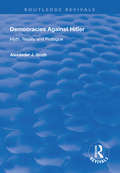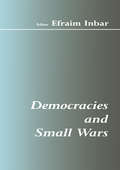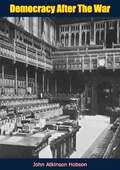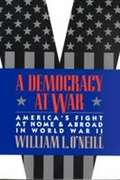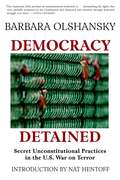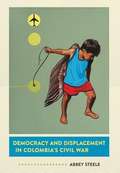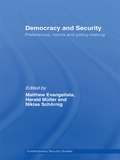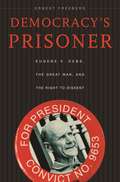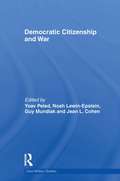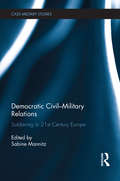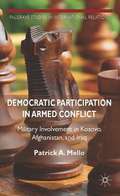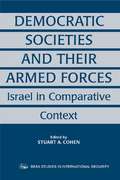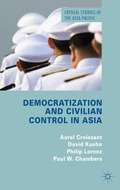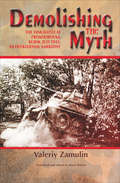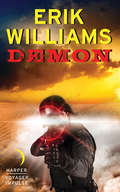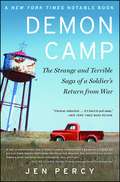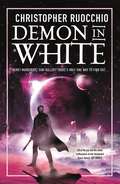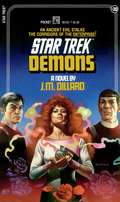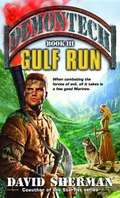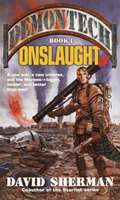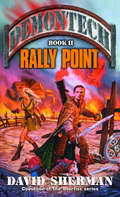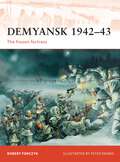- Table View
- List View
Democracies Against Hitler: Myth, Reality and Prologue (Routledge Revivals)
by Alexander J. GrothFirst published in 1999, what the confrontation between democracies and Hitlerism tells us about democracy is the subject of this book. It examines the response of political democracies to the phenomenon of Hitlerism, beginning with democracy in Germany itself in the ’20’s and ’30’s, and ending up with Britain and the U.S. in the ’40’s. Contrary to mythology, this response was far more a failure than a success. An iconoclastic treatment, it anticipates the crises of the future..
Democracies and Small Wars
by Efraim InbarBy their nature, democracies clearly have greater constraints than autocratic regimes on their freedom of action as they have to meet constitutional, legal and moral criteria in their use of force. This collection analyses a number of case studies showing how democracies have won small wars.
Democracy After The War
by John Atkinson HobsonJohn Atkinson Hobson's 'The Fight for Democracy' looks at the state of British democracy after the First World War, outlining the various forces of capitalism, conservatism, militarism, imperialism, protectionist, and bureaucracy that stood in its way and had been strengthened by the conflict. Contents include: 'How to Break the Vicious Circle', 'The new Economic Situation', 'Two Problems for Labour', 'The Conquest of the State', and 'The Close State v. Internationalism'. John Atkinson Hobson (1858 - 1940) was an English social scientist and economist most famous for his work on imperialism—which notably had an influence on Vladimir Lenin-as well as his theory of underconsumption. His early work also questioned the classical theory of rent and predicted the Neoclassical 'marginal productivity' theory of distribution.
Democracy At War: America's Fight at Home and Abroad in World War II
by William L. O'NeillAs America fought to defend democracy in Europe and Asia during World War II, its own democratic politics both aided and impeded the war effort at home and the military campaigns abroad.
Democracy Detained: Military Tribunals and the Threat to Democracy
by Barbara Olshansky Nat HentoffDemocracy Detained exposes the deplorable secret crimes committed by the Bush administration in their war on terror. Prominent legal activist Barbara Olshansky documents the assault on our constitutional democracy since 9/11, meticulously analyzing the unlawful justifications made by the U.S. government for covert actions at home and abroad. She reports on current shocking practices, from the outsourcing of torture through extraordinary rendition, to first-person testimony from innocent men imprisoned without charge at Guantánamo Bay, to revelations of a surveillance network tapped into the homes of average citizens. Democracy Detained is an essential resource for Americans concerned about their civil rights.
Democracy and Displacement in Colombia's Civil War
by Abbey SteeleDemocracy and Displacement in Colombia’s Civil War is one of few books available in English to provide an overview of the Colombian civil war and drug war. Abbey Steele draws on her own original field research as well as on Colombian scholars’ work in Spanish to provide an expansive view of the country’s political conflicts. Steele shows how political reforms in the context of Colombia’s ongoing civil war produced unexpected, dramatic consequences: democratic elections revealed Colombian citizens’ political loyalties and allowed counterinsurgent armed groups to implement political cleansing against civilians perceived as loyal to insurgents.
Democracy and Race: Asian Americans and World War II
by Ronald T. TakakiExperiences that Asian Americans had, during World War II.
Democracy and Security: Preferences, Norms and Policy-Making (Contemporary Security Studies)
by Matthew Evangelista Niklas Schörnig Harald MüllerIt has become generally accepted wisdom that democracies do not go to war against each other. However, there are significant differences between democratic states in terms of their approach to war and security policy in general. This edited book offers a broad examination of how democratic preferences and norms are relevant to security policy beyond the decision of whether to go to war. It therefore offers a fresh understanding of state behaviour in the security realm. The contributors discuss such issues as defence policy, air war, cluster bombs, non-lethal weapons, weapons of mass destruction, democratic and non-democratic nuclear weapon states’ transparency, and the political and ideological background of the ongoing ‘Revolution in Military Affairs’. It has become generally accepted wisdom that democracies do not go to war against each other. However, there are significant differences between democratic states in terms of their approach to war and security policy in general.
Democracy's Prisoner: Eugene V. Debs, the Great War, and the Right to Dissent
by Ernest FreebergIn 1920, socialist leader Eugene V. Debs ran for president while serving a ten-year jail term for speaking against America’s role in World War I. Though many called Debs a traitor, others praised him as a prisoner of conscience, a martyr to the cause of free speech. Nearly a million Americans agreed, voting for a man whom the government had branded an enemy to his country. In a beautifully crafted narrative, Ernest Freeberg shows that the campaign to send Debs from an Atlanta jailhouse to the White House was part of a wider national debate over the right to free speech in wartime. Debs was one of thousands of Americans arrested for speaking his mind during the war, while government censors were silencing dozens of newspapers and magazines. When peace was restored, however, a nationwide protest was unleashed against the government’s repression, demanding amnesty for Debs and his fellow political prisoners. Led by a coalition of the country’s most important intellectuals, writers, and labor leaders, this protest not only liberated Debs, but also launched the American Civil Liberties Union and changed the course of free speech in wartime. The Debs case illuminates our own struggle to define the boundaries of permissible dissent as we continue to balance the right of free speech with the demands of national security. In this memorable story of democracy on trial, Freeberg excavates an extraordinary episode in the history of one of America’s most prized ideals.
Democratic Citizenship and War (Cass Military Studies)
by Jean L. Cohen Yoav Peled Noah Lewin-Epstein Guy MundlakThis edited volume explores the theoretical and practical implications of war and terror situations for citizenship in democratic states. Citizenship is a key concept in Western political thought for defining the individual’s relations with society. The specific nature of these rights, duties and contributions, as well the relations between them, are determined by the citizenship discourses that prevail in each society. In wartime, including low-intensity wars, democratic societies face different challenges than the ones facing them during peacetime, in areas such as human rights, the status of minorities, the state’s obligations to its citizens, and the meaning of social solidarity. War situations can affect not only the scope of citizenship as an institution, but also the relations between the prevailing discourses of citizenship and between different groups of citizens. Since 9/11 and the declaration of the 'war on terror', many democracies have been grappling with issues rising out of the interface between citizenship and war. This volume examines the effects of war on various aspects of citizenship practice, including: immigration and naturalization, the welfare state, individual liberties, gender relations, multiculturalism, social solidarity, and state – civil society relations. This book will be of great interest to students of military studies, political science, IR and security studies in general.
Democratic Civil-Military Relations: Soldiering in 21st Century Europe (Cass Military Studies)
by Sabine MannitzThis book examines the ways in which European democracies, including former communist states, are dealing with the new demands placed on their security policies since the cold war by transforming their military structures, and the effects this is having on the conceptualisation of soldiering. In the new security environment, democratic states have called upon their armed forces increasingly to fulfil unconventional tasks – partly civilian, partly humanitarian, and partly military – in most complex, multi-national missions. Not only have military structures been transformed to make them fit for these new types of deployments, but the new mission types highlight the necessity for democracies to come to terms with a new image and ethos of soldiering in defence of a transnational value community. Combining a qualitative comparison of twelve countries with an interdisciplinary methodology, this edited volume argues that the ongoing transformations of international politics make it necessary for democracies to address both internal and external factors as they shape their own civil-military relations. The issues discussed in this work are informed by Democratic Peace theory, which makes it possible to investigate relations within the state at the same time as analysing the international dimension. This approach gives the book a systematic theoretical framework which distinguishes it from the majority of existing literature on this subject. This book will be of much interest to students of civil-military relations, European politics, democratisation and post-communist transitions, and IR in general.
Democratic Militarism
by Jonathan D. CaverleyWhy are democracies pursuing more military conflicts, but achieving worse results? Democratic Militarism shows that a combination of economic inequality and military technical change enables an average voter to pay very little of the costs of large militaries and armed conflict, in terms of both death and taxes. Jonathan Caverley provides an original statistical analysis of public opinion and international aggression, combined with historical evidence from the late Victorian British Empire, the US Vietnam War effort, and Israel's Second Lebanon War. This book undermines conventional wisdom regarding democracy's exceptional foreign policy characteristics, and challenges elite-centered explanations for poor foreign policy. This accessible and wide ranging book offers a new account of democratic warfare, and will help readers to understand the implications of the revolution in military affairs.
Democratic Participation in Armed Conflict
by Patrick A. MelloUnder which conditions do democracies participate in war, and when do they abstain? Providing a unique theoretical framework, Mello identifies pathways of war involvement and abstention across thirty democracies, investigating the wars in Kosovo, Afghanistan and Iraq.
Democratic Societies and Their Armed Forces: Israel in Comparative Context
by Stuart A. CohenThese papers are an edited selection from the BESA conference of 1998. They present an overview of transformations in societal-military relations in the western world, and the specific manifestations in Israel.
Democratization and Civilian Control in Asia
by Aurel Croissant David Kuehn Philip Lorenz Paul W. Chambers##description##
Demolishing the Myth: The Tank Battle at Prokhorovka, Kursk, July 1943: An Operational Narrative
by Valeriy Zamulin&“Comprehensive scholarship and convincing reasoning, enhanced by an excellent translation, place this work on a level with the best of David Glantz&” (Dennis Showalter, award-winning author of Patton and Rommel). This groundbreaking book examines the battle of Kursk between the Red Army and Wehrmacht, with a particular emphasis on its beginning on July 12, as the author works to clarify the relative size of the contending forces, the actual area of this battle, and the costs suffered by both sides. Valeriy Zamulin&’s study of the crucible of combat during the titanic clash at Kursk—the fighting at Prokhorovka—is now available in English. A former staff member of the Prokhorovka Battlefield State Museum, Zamulin has dedicated years of his life to the study of the battle of Kursk, and especially the fighting on its southern flank involving the famous attack of the II SS Panzer Corps into the teeth of deeply echeloned Red Army defenses. A product of five years of intense research into the once-secret Central Archives of the Russian Ministry of Defense, this book lays out in enormous detail the plans and tactics of both sides, culminating in the famous and controversial clash at Prokhorovka on July 12, 1943. Zamulin skillfully weaves reminiscences of Red Army and Wehrmacht soldiers and officers into the narrative of the fighting, using in part files belonging to the Prokhorovka Battlefield State Museum. Zamulin has the advantage of living in Prokhorovka, so he has walked the ground of the battlefield many times and has an intimate knowledge of the terrain. Examining the battle primarily from the Soviet side, Zamulin reveals the real costs and real achievements of the Red Army at Kursk, and especially Prokhorovka. He examines mistaken deployments and faulty decisions that hampered the Voronezh Front&’s efforts to contain the Fourth Panzer Army&’s assault, and the valiant, self-sacrificial fighting of the Red Army&’s soldiers and junior officers as they sought to slow the German advance and crush the II SS Panzer Corps with a heavy counterattack at Prokhorovka. Illustrated with numerous maps and photographs (including present-day views of the battlefield), and supplemented with extensive tables of data, Zamulin&’s book is an outstanding contribution to the growing literature on the battle of Kursk, and further demolishes many of the myths and legends that grew up around it.
Demon
by Erik WilliamsMike Caldwell is a CIA assassin who thinks he's finally got a real case to work on. At a remote construction site in Iraq, something deadly and dangerous has been unearthed, and Mike believes he's dealing with a powerful pathogen that turns the infected into primal killing machines. The truth, however, is far worse.The ancient prison of the fallen angel Semyaza has been uncovered, and for the first time in thousands of years he is free to roam the earth, possessing the bodies of the humans he hates. And everywhere he goes, Hell is sure to follow.Now Mike is on Semyaza's trail, hunting a demon whose mere presence turns every living thing near it into a weapon of mass destruction. Both merchants of death are on a collision course, while the fate of humanity hangs in the balance.
Demon Camp: The Strange and Terrible Saga of a Soldier's Return from War
by Jennifer PercyA “chilling” (O, The Oprah Magazine), “darkly brilliant” (Bookforum) account of “the effects of war on the psyches of the soldiers who fight” (Esquire).In 2005 a Chinook helicopter carrying sixteen Special Ops soldiers crashed during a rescue mission in Afghanistan, killing everyone on board. In that instant, machine gunner Caleb Daniels lost his best friend, Kip, and seven members of his unit. Back in the US, Caleb begins to see them everywhere—dead Kip, with his Alice in Wonderland tattoos, and the rest of them, their burned bodies always watching him. But there is something else haunting Caleb, too—a presence he calls the Black Thing, or the Destroyer, a paralyzing horror that Caleb comes to believe is a demon. Alone with these apparitions, Caleb considers killing himself. There is an epidemic of suicide among veterans of Iraq and Afghanistan, men and women with post-traumatic stress disorder who cannot cope with ordinary life in the aftermath of explosions and carnage. Author Jen Percy finds herself drawn to their stories. Her main subject, Caleb, has been bringing damaged veterans to a Christian exorcism camp in Georgia that promises them deliverance from the war. As Percy spends time with these soldiers and exorcists—finding their beliefs both repellant and magnetic—she enters a world of fanaticism that is alternately terrifying and welcoming. With “beautiful, lucid” (Los Angeles Times) lyricism, Demon Camp is the riveting true story of a veteran with PTSD and an exploration of the battles soldiers face after the war is over. As The New York Times Book Review said, “Percy’s narrative may confirm clichés about war’s costs, but it artfully upsets a common misconception that all veterans’ experiences are alike.”
Demon in White: Book Three (Sun Eater #3)
by Christopher RuocchioThe third novel of the galaxy-spanning Sun Eater series merges the best of space opera and epic fantasy, as Hadrian Marlowe continues down a path that can only end in fire.Hadrian and his Red Company have been serving the Empire in military engagements against the Cielcin, the vicious alien civilisation bent on humanity's destruction. And they've been successful: a cult-like fervour building around Hadrian following a particularly impressive victory. But popularity comes at a price: an assassination attempt, triggered by those within the Imperial government who are scared of his rise to prominence.Now the Empire has turned dangerous, Hadrian and his crew leave to pursue his true interest: a search for a long-rumoured connection between the first Emperor and the Quiet: the ancient, seemingly long-dead race. And he will find the next key to unlocking their secrets in a massive library on a distant world.The coordinates for their origin planet.A planet that no longer holds life, but may still contain answers.'Empire of Silence is epic science fiction at its most genuinely epic. Ruocchio has made something fascinating here, and I can't wait to see what he does next' James S.A. Corey, New York Times-bestselling author of The Expanse novels'Empire of Silence is a rich tapestry of future history and worldbuilding, a galactic-sized story of a hero, a tyrant, but portrayed as a man' Kevin J. Anderson, New York Times-bestselling author of The Dark Between the Stars
Demon in White: Book Three (Sun Eater)
by Christopher RuocchioThe third novel of the galaxy-spanning Sun Eater series merges the best of space opera and epic fantasy, as Hadrian Marlowe continues down a path that can only end in fire.Hadrian and his Red Company have been serving the Empire in military engagements against the Cielcin, the vicious alien civilisation bent on humanity's destruction. And they've been successful: a cult-like fervour building around following a particularly impressive victory. but popularity comes as a price: an assassination attempt, triggered by those within the Imperial government who are scared of his rise to prominence.Now the Empire has turned dangerous, Hadrian and his crew leave to pursue his true interest: a search for a long-rumoured connection between the first Emperor and the Quiet, the ancient, seemingly long-dead race. And he will find the next key to unlocking their secrets in a massive library on a distant world. The coordinates for their origin planet.A planet that no longer holds life, but may still contain answers.'Empire of Silence is epic science fiction at its most genuinely epic. Ruocchio has made something fascinating here, and I can't wait to see what he does next' James S.A. Corey, New York Times-bestselling author of The Expanse novels'Empire of Silence is a rich tapestry of future history and worldbuilding, a galactic-sized story of a hero, a tyrant, but portrayed as a man' Kevin J. Anderson, New York Times-bestselling author of The Dark Between the Stars
Demons (Star Trek: The Original Series #30)
by J.M. DillardDemons Long before the Federation, powerful force invaded our galaxy and almost destroyed it... a force that began with possession and madness, and ended in murder! A Starfleet research expedition to the farthest reaches of the galaxy has unearthed that force once again... and brought its silent evil back to the planet Vulcan. Now Spock must defeat the demons that threaten his friends and family,or the Enterprise will become the instrument of the galaxy's destruction!
Demontech: Gulf Run (Demontech)
by David ShermanOnly a miracle can save them now. Luckily, they have one: the Marines. Like an invincible tidal wave of evil, the Dark Prince&’s conquering armies roar across the land, leaving death and destruction in their wake. So far Marines Haft and Spinner have managed to stay one step ahead of the invaders, picking up hundreds of refugees and soldiers as they struggle to reach their salvation at the edge of the sea. Against all odds, they&’ve even managed to inflict some damage on the vastly superior forces. Yet for every enemy soldier killed, ten more appear in his place, and the Dark Prince&’ s demon magic ensures their weapons are brutally effective. The outlook is not promising for the ragged band of rebels, pursued by bloodthirsty troops, hounded by bandits, and forced across a desert where death awaits all trespassers. As the noose tightens and the Dark Prince prepares the final coup de grace, it may look like Haft and Spinner and their embattled crew are finished. But these Marines have only just begun to fight.
Demontech: Onslaught (Demontech)
by David ShermanThe diabolic armies appear invincible–but they haven&’t met the Marines. The Dark Prince&’s power to summon demons has made his forces second to none, and ensured his place as one of the invasion&’s leaders. Not content to merely seize his father&’s throne, the renegade royal dreams of world conquest–and with his army and his black arts, there is little to stop him. So unexpected, so well planned is the invasion of the free port New Bally that out of hundreds in the city, only two escape capture. Haft and Spinner will need all their courage and cunning to retrieve their weapons from their enemy-held ship, cross the open meadows surrounding the city walls, and escape into the forest beyond–where they hope to regroup and drive back the invaders. Luckily, Haft and Spinner are no ordinary men. They are Marines . . .
Demontech: Rally Point (Demontech)
by David ShermanRuthless and seemingly indestructible, the dark army didn&’t count on the few, the proud, the Marines. The Dark Prince&’s vast armies have destroyed nation after nation with the aid of powerful demon magic. Their total victory would be swift and certain except for two things: Haft and Spinner, a pair of soldiers trained in the art of warfare through the teachings of a magically transported Marine Gunnery Sergeant. The Dark Prince&’s orders are swift and simple: find them. Haft and Spinner, along with scores of soldiers and refugees, are determined to form an army and defeat the invaders. Outnumbered and outgunned, they must uncover and kill the enemy before the enemy kills them. Haft and Spinner have already accomplished great feats. But to achieve the impossible will require a few strokes of genius and a few good men. Fortunately, these Marines have both. . . .
Demyansk 1942-43
by Peter Dennis Robert ForczykThe fighting around the town of Demyansk was one of the longest encirclement battles on the Eastern Front during the Second World War, stretching from February 1942 to February 1943. Originally, the German 16. Armee occupied Demyansk in the fall of 1941 because it was key terrain - a crossroads located on high ground amidst a sea of swampy terrain - that would be used as a springboard for an eventual offensive into the Valdai Hills. Instead, the Soviet winter counteroffensive in February 1942 encircled the German II Armeekorps and other units, totalling about 100,000 troops, inside the Demyansk Pocket. Another pocket was also created around Kholm, with another 5,000 Germans inside. Yet despite severe pounding from five Soviet armies, the embattled German troops held the pocket and the Luftwaffe organized a major aerial resupply effort to sustain the defenders. For the first time in military history, an army was supplied entirely by air.After stopping the Soviet winter counteroffensive, the German 16. Armee mounted two major relief efforts to rescue their trapped forces in the Demyansk and Kholm pockets, which were finally relieved in April-May 1942. During the siege, the crack 3. SS-Division 'Totenkopf' was virtually destroyed, suffering 80 per cent casualties. However, Hitler demanded that the 12 divisions of II Armeekorps remain in the narrow Demyansk salient, whose base was only 6km wide. Throughout the summer and autumn of 1942, the Soviets pounded the salient from all sides, inflicting heavy casualties on the defenders. In February 1943, Marshal Timoshenko was ordered to launch an offensive to cut off the base of the salient and annihilate the 12 divisions. At the same time, Hitler finally came to his senses after the Stalingrad debacle and authorized the 16. Armee to withdraw from the pocket. Thus, the Germans began to withdraw just as Timoshenko opened his grand offensive to cut them off and destroy almost 100,000 German troops. This volume will conclude with the drama of a German army-size withdrawal under fire in winter, under attack from three sides.
